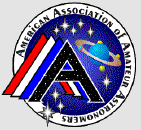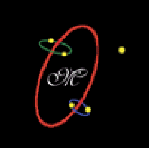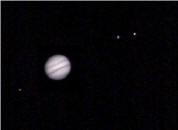|

www.AstroMax.com
Up
Abstract
I. Purpose
II. Background
III. Orbits
IV. Period Determination
V. Methods
VI. Kepler's Laws
VII. Observing Suggestions
VIII. Data Gathering
IX. Data Processing
X. Observer's Data Results
XI. Other Quad-A Results
XII. Conclusions
XIII. Attachments

This Project Jupiter Report
was prepared by
Mizar Consulting
Eugene A. Lanning
130 Hillside Terrace
Nebraska City, NE
68410-3740
ealanni@alltel.net
Member of AAAA
AAAA
The American Association
of Amateur Astronomers
P.O. Box 7981
Dallas, TX
75209-0981
e-Mail:
aaaa@astromax.com
www.AstroMax.com
| |
 Project
Jupiter Project
Jupiter
 
III. Orbits
It has been shown by others that orbiting bodies follow an elliptical shaped
(not egg shaped) orbit about the more massive body. In the early era of
astronomy it was thought that the orbits were circular, as that was regarded as
being more "perfect". Indeed, as a first approximation the orbits are very
nearly circular – with a few exceptions. The circular approximation is
sufficient for the purposes of the work accomplished in Project Jupiter because
of the limitations of separation measuring equipment available to most amateurs.
In the vastness of space, there is no "up" or "down", or preferred direction.
As such, the plane of the orbit of bodies may be at any angle to the observer. In
double star work that is especially true, so the observed orbits may be viewed
as if an observer were perpendicular to the orbit, nearly in the plane of the
orbit, or in between those positions. The differing perspective distorts the
perceived shape of the elliptical orbit. Fortunately for Project Jupiter the
plane of the orbits of Jupiter’s moons are such that the orbit characteristics
may be determined with relative ease.
|
[Home]
[Abstract]
[I. Purpose]
[II. Background]
[III. Orbits]
[IV. Period Determination]
[V. Methods]
[VI. Kepler's Laws]
[VII. Observing Suggestions]
[VIII. Data Gathering]
[IX. Data Processing]
[X. Observer's Data Results]
[XI. Other Quad-A Results]
[XII. Conclusions]
[XIII. Attachments]
|



